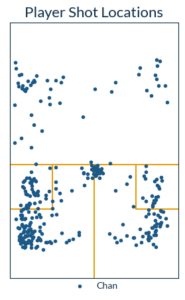

Cross Court Analytics is a York, England-based company which uses a unique and innovative approach to assess squash matches in an objective and statistically rigorous way. A Cross Court Analytics evaluator catalogues every shot selection, shot location, and rally result from an entire match and then categorizes and analyzes the results, looking for patterns and tendencies. CSA is pleased to partner with Cross Court Analytics for this introductory article.
With the College Squash Association (CSA) season drawing to a close in March, Cross Court Analytics broke down the numbers from the 2023 National Collegiate Individual Women’s Championship between Simmi Chan (Columbia University) and Siva Subramaniam (Cornell University). Though Subramaniam started strongly, the defending champion ultimately succumbed to Chan, three games to one.

Chan’s success in this final was underpinned by an attacking mindset. Despite Subramaniam returning a more favorable Winner:Error ratio (15 Winners, 8 Errors), it was Chan’s sheer volume of Winners which tipped the battle in her direction. Chan’s 19 Errors may have been high, but the Columbia player racked up an astonishing 27 Winners, with 25 of these coming in the final 3 Games alone.

It was as if Subramaniam’s one-sided Game 1 win (11-2) forced Chan to reevaluate her strategy: no longer content to try and match the Cornell player’s probing line and length, Chan gambled on aggression. Chan began Game 2 with five Winners and three Unforced Errors, taking the ball short once every five shots, up from once every seven shots in Game 1. One thing was for sure: points would be short one way or the other. The average rally length dropped from 10 shots (15 seconds) in the first game to 7 shots (11 seconds) in the second.

The contrast in styles – Chan the aggressor, Subramaniam becoming more reactive – is seen most clearly in the pair’s backhand shot selections. Subramaniam sought to close down attacking opportunities, hitting 85% of her deep backhand shots down the line. And the Cornell woman was also content to slow the tempo where possible: Subramaniam lifted 28 times from this region, twice as frequently as Chan used height (14).

Chan, by contrast, hit straight from deep on her backhand just 62% of the time, opting to open up angles for attack. And attack she certainly did: from mid-court backhands, Chan took the ball short once every three opportunities (Subramaniam once every seven).

But switching play from deep left and attacking from mid-left was not without its risks for Chan. She hit 12 of her 19 Unforced Errors from these two regions combined (63%).

Once taken into the front, Chan and Subramaniam adopted very different approaches. Subramaniam counter-dropped on half the opportunities she could; Chan, though proactive in taking the ball short from mid-court, typically sought to move play to the back once Subramaniam had countered. The Columbia player hit half of her shots (48.4%) from the front left to deep on Subramaniam’s forehand.

Subramaniam may watch this match back and think she was too predictable from short. As Chan grew into the contest, she was able to read the Cornell player with ever more confidence: closing in on Subramaniam’s forehand counter drop was a particular strength for Chan, who hit the greatest number of her Winners from this front right region (28.6%).

She may have been reading Subramaniam’s game well, but Chan still needed to put away the Winners. She did so in Game 4 with a series of sublime backhand crosscourt volley drops. This was an area of strength for Chan: across the contest, she hit four Winners in this way and just one Error, much improved on her general Winner:Error ratio of 3:2.


Each dot represents the location of a shot played. It may be of interest to note that Chan opted to serve backhand from the right, while Subramaniam chose to serve forehand.
It was Chan’s ability to get on the volley which really paved the way for her success. In points Subramaniam won, Chan volleyed 29% of the time, marginally higher then Subramaniam’s volley rate of 24%. But in points Chan won, she increased her volley rate to a high 35%, and limited Subramaniam’s to just 19%.

The final was played in great spirit, with the contender dethroning the holding champion. Just over one month later, Chan and Subramaniam were drawn against each other again in the opening round of April’s British Open, and Subramaniam avenged her loss with a fairly smooth victory. The 2023 Ramsay Cup National Championship Final is a fantastic advertisement for the high-quality squash played in the US College Squash system and the ability of CSA’s players to compete at the highest level after college.





